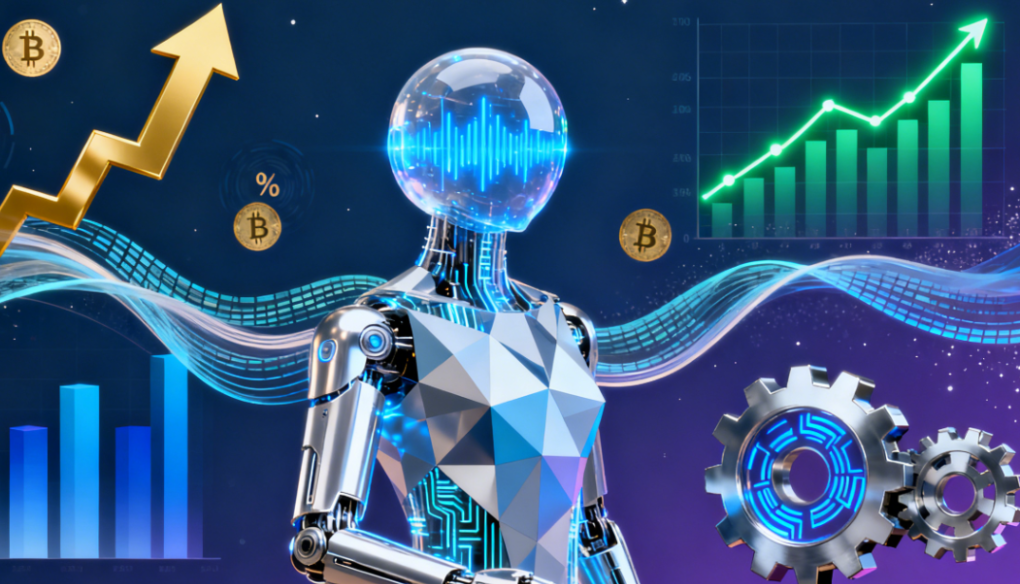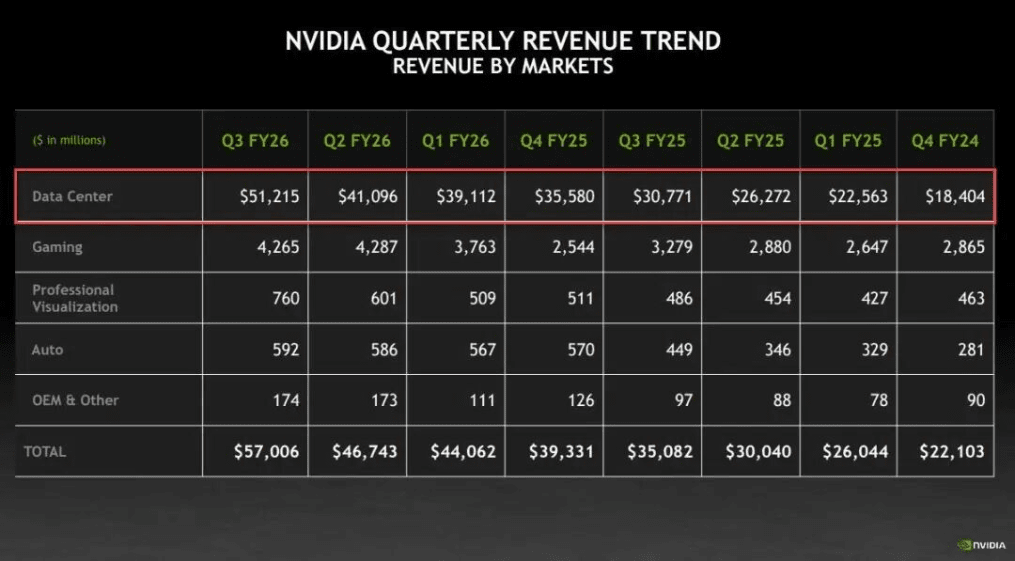The end of the computing power surge is a string of encrypted codes. NVIDIA's latest financial report is impressive, but the capital market's reaction is lukewarm, with the stock price plummeting more than 7% shortly after the report was released.
At the same time, Google's self-developed TPU chip breakthroughs have raised doubts about NVIDIA's future position. A debate about the AI bubble is unfolding in the capital market. MIT's research report has further fueled this debate—up to 95% of companies' investments in AI have failed to produce measurable returns.
 1. NVIDIA's 'no-win situation'
1. NVIDIA's 'no-win situation'
● NVIDIA delivered an astonishing report for the third quarter of fiscal year 2026: revenue of $57 billion, a year-on-year increase of 62%, and a net profit of $31.91 billion, a year-on-year increase of 65%.

● Data center business has become the absolute main force, with revenue reaching $51.2 billion, accounting for nearly 90% of total revenue.

● CEO Jensen Huang excitedly stated after the earnings report that Blackwell architecture chip sales far exceeded expectations, and cloud GPUs are completely sold out.
● However, the capital markets have reacted very differently. Nvidia's stock price fell sharply after a brief surge, with a market value evaporation of over $800 billion from its peak.

Jensen Huang candidly stated in an internal meeting that the company is caught in a 'no-win situation': 'If we deliver a poor quarterly report, it looks a bit unstable, and the whole world will collapse. But even if we deliver an excellent quarter, some will say we are just fueling the bubble.'
Two, the AI bubble dispute
● The market's enthusiasm for AI is beginning to show signs of retreat. The MIT report on the state of commercial artificial intelligence in 2025 reveals a harsh reality: despite companies investing as much as $40 billion in generative AI, 95% of enterprises failed to achieve measurable returns on their investments.
● Research shows that only 5% of organizations have successfully crossed the 'generative AI chasm', creating substantial value through integrated AI pilot projects. The vast majority of enterprises have fallen into a predicament where pilot projects stagnate and fail to have a significant impact on performance.
● More worryingly, a massive 'shadow AI economy' is forming—over 90% of employees prefer to use personal versions of tools like ChatGPT to complete work rather than the AI systems provided by their companies.
● 'Big Short' Michael Burry criticized the cyclical trading around Nvidia by tech companies, pointing out, 'The actual ultimate demand is extremely minimal, and almost all customers are funded by their distributors.'
Three, the power dilemma: the ultimate bottleneck for AI growth
● With the explosive growth in AI computing power demand, electricity supply has become an undeniable bottleneck. Analysis shows that to meet the comprehensive demand of new data centers, electric vehicles, and industrial reshoring, the U.S. now needs to add about 80 gigawatts of generating capacity each year. OpenAI CEO Sam Altman publicly stated, 'The two currencies of the future will be computing power and energy, and AI technology depends on breakthroughs in energy.'
● The high energy consumption of AI computations directly conflicts with global green energy transition goals. Achieving higher computing power requires higher energy consumption and more energy, which could lead to higher carbon emissions.
● In the face of this challenge, tech giants are taking action. In 2023, Amazon announced that its total electricity purchase agreements reached 8.8 GW; Meta announced 3 GW of corporate power purchase agreements; in May 2024, Microsoft signed clean energy purchase agreements worth over $10 billion.
Four, RWA and DePIN: the new financial infrastructure of the AI era
● In the face of insufficient traditional financing channels, a new capital formation mechanism is emerging—tokenization of real-world assets (RWA) and decentralized physical infrastructure networks (DePIN).
● In the AI infrastructure field, high-performance hardware like GPUs is gradually evolving into strategic assets. The RWAiFi path proposed by the GAIB protocol provides a new solution for 'the on-chain financialization of AI infrastructure.'
● GPUs, with their high standardization, clear residual value, and active second-hand market, have become the primary entry point for RWA transformation.
● Specifically, GAIB collaborates with global cloud service providers and data centers to design three types of financing agreements using GPU clusters as collateral: debt model (fixed interest payments), equity model (sharing GPU or robot income), and hybrid model (interest + revenue sharing).

● In the energy sector, DePIN projects like Daylight and Arkreen show how distributed energy—rooftop solar, home batteries, electric vehicle charging stations—can be coordinated into a software-defined power plant.
● Daylight's 'flexible proof' mechanism pays tokens when smart devices commit to adjusting consumption or charge/discharge behavior during future peak times; energy companies burn tokens to purchase access rights to flexible capacity.
Five, from kilowatt-hours to AI tokens: the value of crypto bridges
If DePIN and RWA successfully combine, it will create a complete traceable value chain from energy to computing power.
● On the supply side, kilowatt-hour related outputs can be tokenized, representing claims to specific renewable energy generation flows.
● In the midstream, infrastructure can be expressed as tokenized RWA: equity and debt of data centers, grid connection upgrades, power generation and storage, GPU clusters.
● On the demand side, energy and computing can be linked to AI-native tools: GPU hour tokens, inference second credits, and even application layer 'AI service' tokens.

As a result, every marginal kilowatt-hour used by AI models, from its origin to its consumption in GPU racks, to its monetization in AI applications, is traceable, priceable, and hedgable.
This does not require each link to be on the same chain or priced in the same token. Rather, it means that the state of each link is machine-readable and can be stitched together by smart contracts and agents.
If realized, it essentially creates a new form of capital: any investor, anywhere, can choose where to take risks in this chain—energy, the grid, data centers, GPUs, AI applications—and purchase tokenized exposures of corresponding scale and duration.

The dilemma of power and capital is giving rise to a revolution in financial infrastructure.
When every kilowatt of electricity consumed by AI models can become traceable, priceable, and tradable through blockchain—from the origin of rooftop solar to conversion in GPU racks to value realization in AI applications—a brand new capital network is quietly taking shape.
The balance sheets of large-scale enterprises will not disappear, but they are no longer the only way to warehouse risk. Long-tail, distributed, programmable capital may be the answer to AI breaking through the power and capital bottlenecks.
Join our community to discuss and become stronger together!
Official Telegram community: https://t.me/aicoincn
AiCoin Chinese Twitter: https://x.com/AiCoinzh
OKX benefit group: https://aicoin.com/link/chat?cid=l61eM4owQ
Binance benefit group: https://aicoin.com/link/chat?cid=ynr7d1P6Z




